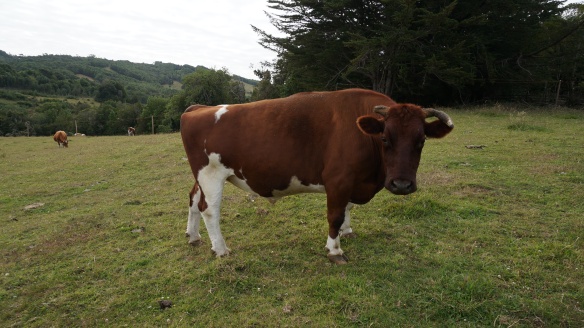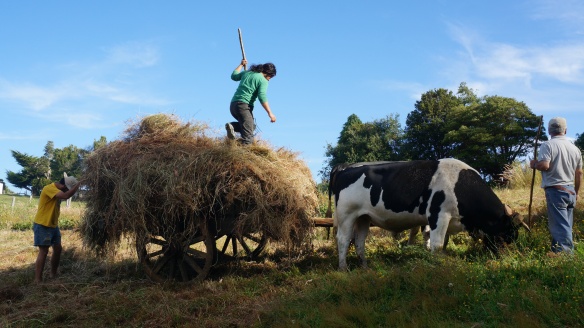I think it was visions of Gina Davis milking cows in ‘A League of Their Own’ that put the romanticism of milking cows in my head. What could be better than milking a cow, then eating the cheese a few days later? The answer to that question is just eating the cheese and being no where near the milk extraction process.

With no good pictures of the milk cows, I present you with a picture of a bull. You get the idea though…
During the first week of wwoofing on the island of Chiloé, I eagerly volunteered Jordan and I to help with the daily milking. Turns out that the cows are up in the summer pasture, so we hiked up to the highest hill to collect the cows with the family patriarch. I tried to pretend that my instinctive ‘flight’ reaction to a cow stepping out of line wasn’t me running away scared, but instead a happy frolic in the meadow. This was off to a tenuous start.
When the cows come down from pasture, the calfs who spent the night away from their milk bearing mothers are each given turns to drink, which also helps get the udders ‘warmed up’ if you will. Once we pried the milk crazed calfs from the udders and secured them behind a fence, we got to work tying the cows’ back legs together so that they would not be able to kick us in the head while we were milking them. It’s tricky though because in order to tie their legs together, you have to put your head right behind them to get the rope around. When I wrote earlier that ‘we’ had to tie the legs together, you can be sure that I just watched as the seasoned farmed did all the work. Once the legs (and consequently the tail) are all tied up, you are ready to grab your short bench and bucket and start milking.
First, we use a little fresh water to rinse the layer of calf saliva from the udders, noting the scabby areas of flesh caused by some over eager baby cows. No one likes calf saliva in their cheese, am I right??! Then, remembering to keep the udder lubricated with the milk you are extracting, you grab hold and try to figure out a pressure/pull combo which makes the milk come out. This can be difficult especially with an endless stream of ‘that’s what she said’ scenarios popping into your head.
Ten minutes later, when I first started to get milk out of my udder and the patriarch had already finished milking two cows, I started to notice the cow leaning. A cow that leans probably doesn’t seem like a event worthy of note, but when you are crouching beneath a behemoth heifer, whose back legs are tied up, you start to realize, ‘wow, if this cow falls over on me, I’ll most certainly die.’ So anyway, I was just coming to terms with the whole leaning thing, when we noticed the beginning of a leg shuffle. Listen to me when I say this, never ignore the leg shuffle of a cow getting milked. In a series of slow motion events, Jordan and I dove out of the way barely in time to avoid a successive eruption of feces, chaotically trying to explode from a knotted tail/leg tie up, followed by a tidal wave of urine that might have been tinged with revenge for the amateur milking job we were doing on this poor cow. We left the muddy milk pen, buckets virtually empty, forearms burning, feeling unclean, emotionally even more so than physically, hoping to forget about the scabby udders threatening to haunt our morning yogurt for the rest of our days.
All jokes aside, what I once thought would be an easy, new thing to learn, turns out to be a difficult job, requiring much strength and skill. It was amazing watching the farm patriarch handle the cows expertly from pasture to milking. If you wondered why most farmers have such strong handshakes, its because they have been milking cows for decades! I was glad to have been given the chance to try milking a cow with expert teachers, and even more grateful for the people out there who do it on a regular basis so I can enjoy the cheese, yogurt and butter that I love so much!
Has anyone else out there ever tried milking cows? How was your experience? We’d love to hear about it.




















































